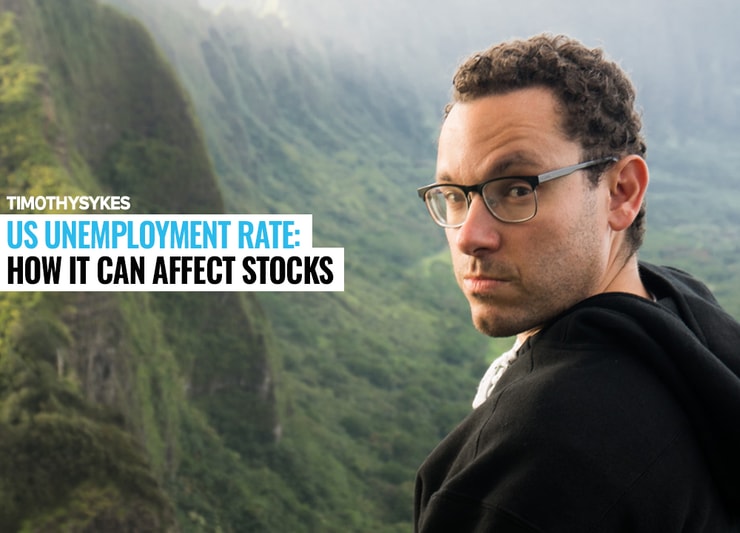As a trader, it’s important to understand the meaning of the unemployment rate and how it can affect your investments. This post explains how the U.S. unemployment rate affects the stock market, and how you can use this information when analyzing stocks to trade.
At first glance, the unemployment rate and the stock market might seem to have nothing in common. But as it turns out, the U.S. unemployment rate has far-reaching ripple effects that reach every industry, including the stock market.
As a trader, it’s wise to understand the meaning of the unemployment rate and how it can affect your investments. This post explains how the U.S. unemployment rate affects the stock market, and how you can use this information when analyzing stocks to trade.
Table of Contents
What is the U.S. Unemployment Rate?

2025 Millionaire Media, LLCUnsurprisingly, the unemployment rate refers to the portion of the job force that is without a job. It’s typically referred to as a percentage.
According to Investopedia, it’s a lagging indicator, which means that it “generally rises or falls in the wake of changing economic conditions, rather than anticipating them. When the economy is in poor shape and jobs are scarce, the unemployment rate can be expected to rise. When the economy is growing at a healthy rate and jobs are relatively plentiful, it can be expected to fall.”
When we refer to the unemployment rate in the U.S., we’re typically referring to what is called the U3, which is part of a monthly employment report issued by the Bureau of Labor Statistics (BLS). This is considered the key report on which the unemployment rate is based.
What Does the Unemployment Rate Actually Show?
The aforementioned U3 rate characterizes unemployed people as individuals who are available to work and who have been seeking out work within the past month.
What counts as employment? Full-time, part-time, and temporary jobs, as well as those who have at least 15 hours of unpaid family work time per week.
Alternative Unemployment Rate Reports
The BLS doesn’t just have the one way of representing the unemployment rate. They also publish other reports, including the U1, U2, U4, U5, and U6.
The U3 is the official unemployment rate report that’s generally referred to in news. However, the other reports also have a lot of information to offer. They’re referred to as measures of labor underutilization. Here’s a brief breakdown of what’s inside the reports:
U1
This report shows the number of people who have been unemployed for 15 weeks or more and is shown as a percentage of the labor force.
U2
This report shows people who lost jobs, had a temporary job end and is shown as a percentage of the labor force.
U4
This report shows not only unemployed people but discouraged workers.
Discouraged workers are the population who are available to work and have tried finding a job but have stopped actively looking. This might be because they can’t find work or have found resistance due to being too old or young or not appropriately qualified. It could also mean those who can’t find work due to discrimination.
This report is adjusted so that the discouraged workers are included in the number of people, so it’s not just the labor force.
U5
This report shows unemployed people and includes those who are marginally attached to the labor force.
This includes the aforementioned discouraged workers, as well as anyone who looked for a job within the past year but gave up their search.
U6
You could call this the big daddy of unemployment rate reports. This report shows unemployed people, and also includes those who are marginally attached to the labor force, but additionally includes those who are employed part time for economic reasons.
The U6 is largely considered the most comprehensive measure the BLS has to offer.
Not only does it include all of the categories from the U5, but it also includes those who have had to settle for part-time jobs — even while desiring full-time jobs — to make ends meet.
This contingent is often called “underemployed.” But this could also include full-time workers who are working in jobs for which they are overqualified.
Unemployment Rate Over Time
The unemployment rate naturally fluctuates over time. Often, policy changes by the government can have an immense effect on the unemployment rate.
The table featured in this blog post provides a fascinating look at the unemployment rate year by year since 1929.
From the momentous unemployment rates following the Great Depression (as high as 24.9 percent unemployment in the years following) to record lows in the 1940s to the moderate rates of recent years, you can often see how the world and political climate can have an effect on unemployment rates.
How Does the Unemployment Rate Affect The Stock Market?

2025 Millionaire Media, LLCIt might seem like there’s a divide between the stock market and the unemployment rate. After all, companies are different than people, right? But actually, there’s a strong and direct connection between the unemployment rate and the stock market.
It works like this: The money that people make from their jobs is the key source of primary income for the majority of U.S. residents. This means that their employment — or lack thereof — is directly responsible for how much money they have.
The amount of money that people have based on their income is the biggest contributor to how much and where they spend their cash. As you might imagine, this has a huge impact on the economy.
So, if the unemployment rate is higher, the general income (and therefore, cash to spend) will be limited. With less cash, people spend less money, and there’s less of a demand for products.
This can mean that stock prices can go down in many areas because there isn’t as much of a demand for certain goods.
For example, during low economic times, things like luxury items will pretty reliably go down in value. When people are simply trying to survive, they don’t have money to buy jewelry or luxury cars.
Put simply, a low unemployment rate can be an indicator of economic expansion, while high unemployment can be an indicator of an underperforming economy.
But it goes beyond that. The unemployment rate is considered an important indicator of the economy at large. This isn’t just because of the number of people unemployed, but because of the ripple effects that it can have on the economy, the value of the dollar, and the stock market.
Something that a lot of people don’t realize is that the size of unemployment rates might have an effect on the Federal Reserve. They might raise or lower interest rates depending on whether the economy is too hot or cold. This can also have an effect on stock and security prices.
More Breaking News
- Mustang Bio’s Drastic Turn: Opportunity or Red Flag?
- TeraWulf Stock Surges Amid Strategic Collaborative Shift
- EHGO’s Unexpected Surge: What to Know
Effects of Low Unemployment Rates
It might seem like low employment rates are a blessing for the stock market. People have jobs and are spending more, so that’s a good thing, right? Sorry, but like so many things in life, it’s not always that simple.
The thing is, the labor market can reach a point when the jobs added aren’t contributing enough to cover the cost of the labor. This creates an extremely inefficient system. That’s referred to as the slack in the labor market or an output gap. The economy doesn’t like slack.
The economy goes up and down, and so does this slack or output gap. If it’s negative, this can be an indication that the labor market isn’t being fully utilized. However, if it’s positive, this could mean that the economy isn’t efficient.
Inflation can also play a role in low unemployment rates. While inflation is natural, sometimes wage inflation exceeds natural inflation, and this isn’t such a great thing. It occurs when the demand for labor is increased because there are fewer workers available and they need to attract workers.
This means that companies are making less profit per worker. This can affect the bottom line for companies and can affect their stocks’ profitability and desirability.
What Traders Can Expect from a Low Unemployment Rate
According to Pension Partners, “A positive correlation between the level of unemployment and forward stock market returns. In general, the lower the unemployment rate, the lower the forward stock market returns and vice versa. In the current quintile (2.5% to 4.4% unemployment), the average S&P 500 return over the following year is 5.6% versus an average of 12.7% in all periods. The best returns historically have come after periods of high unemployment.”
Low unemployment isn’t necessarily a great thing for the stock market. The Federal Reserve has to adjust policy to make jobs, and this can create social and economic problems.
As wages are inflated, companies make less profits, and this affects their worth in the stock market. While unemployment definitely isn’t great for the people who are unemployed, it’s important for the maintained balance of the economy.
Effects of High Unemployment Rates
If low unemployment is less than ideal, does that mean that high unemployment is better? No.
High unemployment obviously isn’t desirable, particularly for those without jobs.
High unemployment also has larger-reaching effects. It means more assistance will be required from state and federal governments to provide unemployment benefits and medical and food assistance.
It also means that the government can’t collect as much in taxes because there isn’t as much income coming into households. This means that the government has to cut back in various ways or to borrow money, neither of which is desirable.
What Traders Can Expect from a High Unemployment Rate
When you think about it on a national level, there are plenty of direct effects for traders when the nation experiences a high unemployment rate.
Since people won’t buy as much during times of high unemployment, the GDP will be reduced. This means that the nation isn’t going to be as efficient or effective in its resource allocation.
Additionally, companies aren’t making more profits by virtue of having fewer employees. They are often charged higher taxes to help bolster the unemployment benefits.
This means that the companies have less money to hire employees. When put in combination with the lesser demand for products, this is bad news for companies and the stocks they offer. This can have long-reaching effects, too, like reduced consumer trust over time.
The Importance of Fundamental Analysis in Unemployment Scenarios
Your methods for conducting trades should never be set in stone.
Even if you’ve come up with a few setups that work reliably, something like a change in the economy, which could be caused by a change in the unemployment rate, could change everything.
As a trader, you can never become complacent in your methods to the point where you’re no longer doing research. You should consider a variety of factors and always meet the market where it is right now, rather than where it once was or where it could be going.
Fundamental analysis is an important tool for traders, and during times of higher or lower unemployment, you should absolutely consider the data in your research.
Trading Challenge
When you’re a student in my Trading Challenge, I don’t just pass you hot stock news. I want to help you build a strong trading foundation that can help you navigate the ever-changing market.
By teaching you how to do research, how to look at chart history, and considering many different things in your fundamental research, I give you the tools you need to forge ahead and create your own identity as a trader.
I didn’t have a mentor when I was starting out in my trading career, but I wish I had. These days, I try to be the mentor I never had for my students.
What Are the Different Unemployment Categories?

2025 Millionaire Media, LLCWithin the term unemployment, there are different categories. Here are some key ones:
Cyclical Unemployment
This is unemployment that’s considered a direct result of the business cycle.
For example, during a recession, there’s a drastically reduced demand for workers, and wages aren’t quick to come to the point where the amount of labor and the supply and demand are back in harmony.
Structural Unemployment
This is unemployment that refers to an imbalance of the jobs available and the skill set of the workers available.
A good example might be when there’s a technological change that renders jobs within a certain industry obsolete. For instance, think of the motor industry.
In situations like this, workers are typically out of work for longer periods and may have to do some training to become relevant. This can be a pretty big problem in the economy.
Frictional Unemployment
This is unemployment that results based on an imbalance of qualified workers and jobs available. For example, consider college grads looking for work, but struggling because all of the available jobs demand experience that they don’t have.
This scenario is hard to avoid. However, this is generally seen as a normal relationship between jobs available and job seekers that evens out over time.
Unemployment Rate Calculation
How is the unemployment rate calculated? Mainly through a duo of surveys that are conducted through the Census Bureau and the BLS.
What Workforce Surveys Are Used to Calculate Unemployment?
How does the government figure out exactly how many people are working? They can’t poll every single person; it’s not efficient. Instead, they rely on two particular surveys for important data: the Current Population Survey (CPS) and the Current Employment Statistics Survey (CES).
Current Population Survey (CPS)
This is a monthly report wherein the U.S. Census Bureau performs an employment survey for the BLS (Bureau of Labor Statistics). This report began in 1940, and the census took over in the early 1940s.
They survey about 60,000 U.S. households and compile the data to report on the employment status, reported as the “Employment Situation.” The report has estimates of the unemployment rate and the amounts of employed and unemployed people in the U.S. based on the survey.
The Employment Situation Summary can be viewed monthly. Then, annually, they also include unemployment and unemployment in concentrated metropolitan areas.
The survey inquires about the employment status of every household member over 15 years of age as of the calendar week that includes the day of the 12th.
Based on the responses, everyone in the household is classified as either employed, unemployed, or not in the labor force.
Current Employment Statistics Survey (CES)
The CES is also an important survey for determining unemployment rates.
According to the U.S. Department of Labor, the CES “produces detailed industry estimates of nonfarm employment, hours, and earnings of workers on payrolls … each month, CES surveys approximately 149,000 businesses and government agencies, representing approximately 651,000 individual worksites.”
Unemployment Reporting Terminology
Here are some additional terms regarding unemployment that can help round out your understanding of the surveys and data available.
Total Employment and the Labor Force
To calculate the unemployment rate, the number of unemployed people is divided by the number of people in the labor force, which consists of all employed and unemployed people. The ratio is expressed as a percentage.
Persons Not in the Labor Force
When you refer to persons, not in the labor force, this means people who are not employed nor are they unemployed. They’re not looking for work, but they are not discouraged workers.
This includes people who are retired, students, stay-at-home parents, caretakers, and so on.
Industry Payroll Employment basics
To be considered employed, you have to be on an established payroll.
In the aforementioned surveys, people are counted as employed if they’re on a payroll for any portion of the pay period, including the 12th day of the month.
This includes full-time employees and part-time employees. It includes temporary and intermittent employees too, as well as those who are on paid holidays, sick leave, or who only work for part of the pay period in question.
Workers on strike, provided they work for a portion of the period in the survey, are also included.
Weekly Hours
The expected duration of employment for the week, which is often shown as the number of hours.
Hourly and Weekly Earnings
Wages or salary earned before taxes or other deductions are taken out. This includes overtime rates, tips, bonuses, and commissions.
If earnings are reported on a different time scale (such as hourly or biweekly), the amount is converted to the equivalent weekly rate.
The Bottom Line
As much as the stock market and the employment rate may seem to reside in separate sectors of society, they’re intrinsically connected.
The stock market can strongly react to the unemployment rate, and it can affect your investments and the economy’s climate.
By considering the unemployment rate and keeping track of the economy at large, you can potentially make more educated decisions about investments.
Do you consider the unemployment rate in your stock research?











Leave a reply